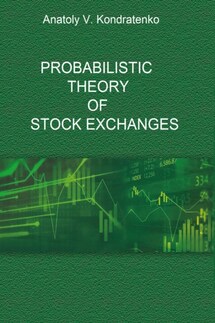Probabilistic Theory of Stock Exchanges - страница 27
Fig. 1.7. Graphical representation in the rectangular two-dimensional coordinate system [P, S& D] of one-dimensional quantity functions d>Q(q) and s>Q(q) as two-dimensional curves with maxima at quantities q>D and q>S and widths Г>DQ and Г>S>Q respectively. The values used for the widths are: Г>DQ = 26.4 ton / year, Г>SQ = 6.8 ton/year.
Below we will discuss in detail all new concepts, main features and calculation details for our simplest two-agent system, so that we will not be distracted by their discussion in further consideration of more complex issues concerning the exchange. So, by definition and in its essence, the probabilistic function of demand D(p,q) (supply S(p,q)) is the probability of the buyer (seller) concluding a deal to buy and sell the traded goods in quantity q at price p. If this is so, then, according to the standard concepts of probability theory, it is natural to define the probability of the transaction under these conditions as the multiplication of these probabilities:
We call this probability of making a deal a market deal function, and, for convenience, we also refer it to the market functions of supply and demand. Like the market functions D(p, q) and S(p, q), it is dimensionless. For the sake of certainty, let us explain that, generally speaking, purchase and sale transactions can occur in the market at any time, at any price and in any quantity, within reasonable limits, but with varying degrees of probability. But if the transaction function is a sufficiently high and narrow bell with a single maximum with the parameters p>M and q>M, then almost all transactions will occur in the proximity of these values, so it is reasonable to consider these very values to be market prices and quantities. If the function of transactions looks otherwise, of course, these definitions are somewhat meaningless, and one should consider the mechanism of probabilistic pricing in detail. Below we will always assume that the function of transactions is such as to allow market prices and quantities to be determined in a fairly simple way. This is exactly the case we have graphically presented in Fig. 1.10 for our two-agent model of the grain market.
Fig. 1.8. Graphical representation in a rectangular three-dimensional coordinate system [P, Q, S&D] of the two-dimensional buyer demand function as a three-dimensional surface D (p, q) with a maximum at the point A (p>D, q>D) in the plane (P, Q).
Fig. 1.9. Graphical representation in the rectangular three-dimensional coordinate system [P, Q, S&D] of the two-dimensional seller's supply function as a three-dimensional surface S(p, q) with a maximum at point B (p>S, q>S) in the plane (P, Q).
As expected, the surface of the market transaction function F(p, q) has only one maximum. For multi-agent economies, the structure can be much more complex.
Fig. 1.10. Three-dimensional graphical representation in a rectangular three-dimensional coordinate system [P, Q, F] of the three-dimensional deal surface F(p, q) in the form of a high and narrow bell with one maximum at the point C (p>M, q>M) in the plane (P, Q). The graphical method of calculation gives the following results for market prices and quantities:







